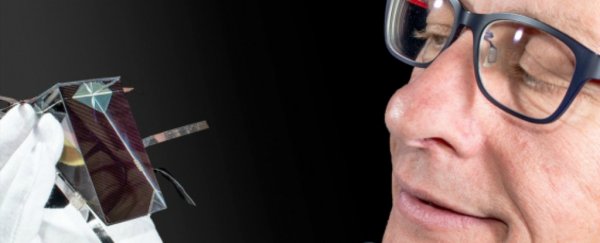Australian engineers have taken us closer than ever before to the theoretical limits of sunlight-to-electricity conversion, by building photovoltaic cells that can harvest an unheard-of 34.5 percent of the Sun's energy without concentrators - setting a new world record.
The previous record of 24 percent was held by a large, 800-square centimetre solar cell produced by a US company, but these new photovoltaic cells aren't only more efficient, they also cover far less surface area, which means they're going to make solar power even cheaper.
"This encouraging result shows that there are still advances to come in photovoltaics research to make solar cells even more efficient," said one of the researchers, Mark Keevers, from the University of New South Wales (UNSW) in Sydney. "Extracting more energy from every beam of sunlight is critical to reducing the cost of electricity generated by solar cells as it lowers the investment needed, and delivering payback faster."
This UNSW team is the same one that set a new solar conversion record back in 2014, by using mirrors to concentrate sunlight and achieve 40 percent efficiency. But this new record is even more impressive, because it didn't involve any concentration, and it was something engineers hadn't expected to achieve for several decades.
"A recent study by Germany's Agora Energiewende think tank set an aggressive target of 35 percent efficiency by 2050 for a module that uses un-concentrated sunlight, such as the standard ones on family homes," said one of the researchers, Martin Green. "So things are moving faster in solar cell efficiency than many experts expected."
The new cell is only 28 square centimetres (11 square inches) and it works by splitting the incoming sunlight into four bands.
The infrared band of that light is reflected back towards a silicon solar cell, and the other three bands are directed into a three-layer, new type of solar cell, made of: indium-gallium-phosphide; indium-gallium-arsenide; and germanium.
The sunlight passes through each of these layers, or junctions, and energy is extracted by each at its most efficient wavelength. Any unused light passes on to the next layer, and so on, to squeeze the most out of every single beam.
You can see a diagram of what that looks like below:
 UNSW Engineering
UNSW Engineering
To be clear, these four-junction solar cells aren't likely to end up on the rooftop of your home or office anytime soon - they're harder to maintain and more expensive than the standard single-junction solar cells we're used to seeing.
But this type of photovoltaic cell is ideal for solar towers, which use mirrors to concentrate sunlight onto a series of cells, and then convert that directly into electricity, often through heat - as is this case in this giant Moroccan solar plant. Or this record-breaking system in Sweden and Australia.
The team is now looking to scale-up its solar cells and see what kind of results they can achieve when they're 800-square centimetres in size, like the previous record holders.
Right now, the theoretical limit for a four-junction device is thought to be 53 percent, which means even with their tiny cell, the UNSW team is two-thirds of the way there.
"There'll be some marginal loss from interconnection in the scale-up, but we are so far ahead that it's entirely feasible," said Keevers.
The potential of this new technology, once it's applied to large-scale solar plants, is going to be pretty exciting for the already-dropping cost of solar electricity, and we can't wait to see what happens next.
The 34.5 percent efficiency record has been confirmed by the US National Renewable Energy Laboratory, and the researchers are awaiting peer review.
UNSW Engineering is a sponsor of ScienceAlert. Find out more about their research.
